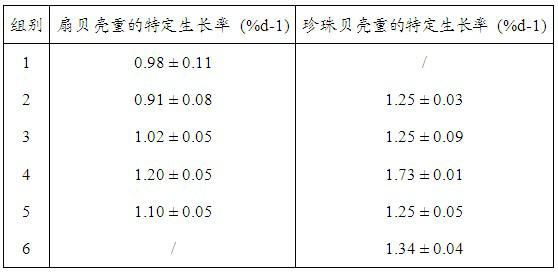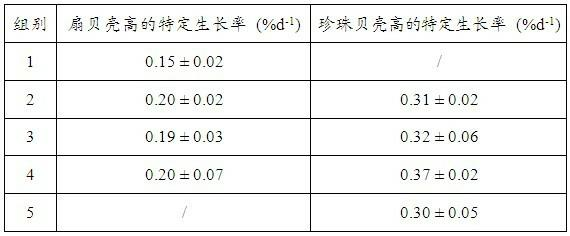Method for cultivating pinctada martensi
A technology of pearl oyster martensii and breeding methods, applied in fish farming, application, climate change adaptation, etc., can solve the problems of high mortality, serious fouling organisms, slow growth, etc., to promote healthy growth, good Ecological benefit, the effect of increasing growth rate
- Summary
- Abstract
- Description
- Claims
- Application Information
AI Technical Summary
Problems solved by technology
Method used
Image
Examples
Embodiment 1
[0014] The polyculture of embodiment 1 Pinctada martensii and the luxurious Chlamys farreri (2009)
[0015] The polyculture method of the present invention: take 50 individuals of Pinctada martensii and Chlamys grandis respectively, measure their initial shell height, shell length, and shell width with a vernier caliper, weigh the shellfish with an electronic balance, and then mix the two shellfish. Divided into 5 groups: Group 1, 40 scallops; Group 2, 30 scallops + 10 pearl oysters; Group 3, 20 scallops + 20 pearl oysters; Group 4, 10 scallops + 30 pearl oysters; Group 5, 40 pearl oysters. Each group of shellfish was placed in 5-layer long cages, with 40 individuals in each layer, for the cultivation of Pinctada martensii and Chlamys farreri.
[0016] Samples were taken at the third month of breeding, and the shell height, length and width of the two shellfish were measured with a vernier caliper, weighed with an electronic balance, and the attached biomass was calculated ...
Embodiment 2
[0028] The polyculture of embodiment 2 Pinctada martensii and the luxurious Chlamys farreri (2010)
[0029] The polyculture method of the present invention: take 50 individuals of Pinctada martensii and Chlamys grandis respectively, measure their initial shell height, shell length, and shell width with a vernier caliper, weigh the shellfish with an electronic balance, and then mix the two shellfish. Divided into 6 groups: Group 1, 40 scallops; Group 2, 33 scallops + 7 pearl oysters; Group 3, 30 scallops + 10 pearl oysters; Group 4, 10 scallops + 30 pearl oysters; Group 5, 7 scallops + 33 pearl oysters; 6 groups, 40 pearl oysters. Each group of shellfish was placed in 5-layer long cages, with 40 individuals in each layer, and the mixed culture of Pinctada martensii and Chlamys farreri was carried out.
[0030] Samples were taken at the 6th month of cultivation, the shell height, length and width of the shellfish were measured with a vernier caliper, weighed with an electroni...
PUM
 Login to View More
Login to View More Abstract
Description
Claims
Application Information
 Login to View More
Login to View More - R&D
- Intellectual Property
- Life Sciences
- Materials
- Tech Scout
- Unparalleled Data Quality
- Higher Quality Content
- 60% Fewer Hallucinations
Browse by: Latest US Patents, China's latest patents, Technical Efficacy Thesaurus, Application Domain, Technology Topic, Popular Technical Reports.
© 2025 PatSnap. All rights reserved.Legal|Privacy policy|Modern Slavery Act Transparency Statement|Sitemap|About US| Contact US: help@patsnap.com



